
HP's First-ever Acquisition
An engineer making measurements generates a lot of data, which traditionally was entered by hand into the engineer's Lab Notebook. In the 1950s, these tedious and frustrating tasks were on the minds of instrument companies who were looking for ways to log data or display data results on paper records. By the end of the 1950s, the 200 highly diversified lines of measuring and signal-generating instruments produced by HP, would each require, in the R&D labs or in manufacturing, data logging instruments to automate these tedious and error-prone manual tasks. Unfortunately, at this time, there were not any of those kinds of data recorder in the Hewlett Packard catalog. This could be considered as a good reason why the F.L. Moseley Co., formed in 1951, was HP's first-ever acquisition in 1958. The Moseley company was already well known to HP because both companies used common independent Sales Representatives.
In the late 1920s, Francis L. Moseley, conceived the idea of an x-y recorder. An x-y recorder is an electromechanical device that produces permanent graphical displays of two electric-input variables as they relate to each other, and to trace them on chart paper automatically, rather than tracking them by hand. The x-y recorder plots on a single stable chart. But when one of these two variables is time, then there is a need for continuous recording, and the chart advances with time. Such a recorder is named a Strip Chart Recorder, and it integrates some kind of accurate time base which advances the paper on a calibrated x-axis.
In 1958, the Pasadena, California-based F.L. Moseley offering was a full line of strip chart and x-y recorders perfectly complementing the HP product lines. The association made it possible further development and improvement of the Moseley graphic recording instruments, which by then had become a standard in the industry.
Moseley Co. would remain an affiliate of Hewlett-Packard Co. up to mid-1960s, as the Hewlett-Packard Moseley Division. The recorder product line stayed listed as Moseley-brand products up to the 1965 catalog, and was fully integrated as Hewlett-Packard instrument in the 1967 general catalog.
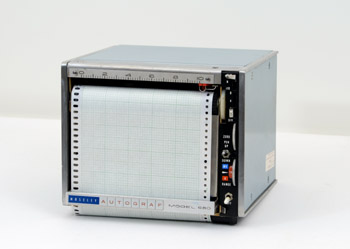 |
The Moseley Model 680 Strip Chart Recorder
HP Memory Project Collection
|
The Moseley Model 680
Strip Chart Recorder
The Moseley "AUTOGRAPH" Model 680 was the first Strip Chart Recorder to be listed in a Hewlett Packard catalog.
It appeared in the 1963 issue, which was the first catalog to include an additional product listing for the first four companies recently acquired by Hewlett Packard. They were: Boonton Radio, Dymec, F. L. Moseley, and Sanborn.
The Model 680 was a compact 6" wide, general purpose strip chart recorder. It was all solid state, with 10 ranges from 5 mV to 100 V full scale, and 8 chart speeds. It used a capillary-fed ink pen supplied from a replaceable ink cartridge or by a stylus on pressure-sensitive paper.
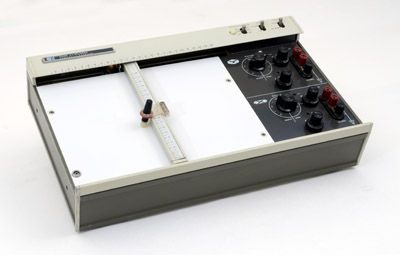 |
HP 7035B
|
The HP 7035B
The 7035B is a high-quality, low cost instrument designed for use in general purpose applications. Each axis has an independent servo system with no interaction between channels. The 7035B plots the x- and y- position, responding to two DC signals representing the function being measured. Plotting performance is based on reproduction accuracy as well as mechanical response time.
Input terminals accept either open wires or plug-type connectors. Five calibrated ranges from 0.4 mV/cm (1 mV/in.) to 4 V/cm (10 V/in.) are provided in each axis. A variable range control permits scaling of signal for full scale deflection. High input impedance (1 megohm on all but the first two ranges), floated and guarded input, and 0.2% accuracy is provided. These specifications assure that connection flexibility is available to the measurement setup.
Each closed-loop servo system uses a high-gain, solid-state servo amplifier, servo motor, long-life balance potentiometers, photo-chopper, low pass filter, guarded inputs, and attenuator and balance circuit.
A plug-in time base, Model 17108A, operates on either axis to provide five sweep speeds from 0.2 to 20 s/cm. Of course, since the chart paper does not move, the measurement time limit is set by the time-axis selection. The unit is self-contained, external, and designed to directly plug into the 7035B input terminals. Any number of recorders may be driven simultaneously, provided the combined parallel input resistance is 20 kΩ or more.
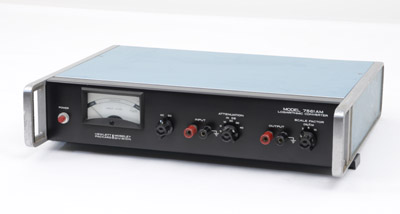 |
Hewlett Packard Moseley Division 7561AM Logarithmic Converter
HP Memory Project Collection
|
A Common and Useful Accessory in the Early Time of the Recorder Era
It was the Model 60D in the Moseley catalog, and became the HP 7561AM in the HP catalog in 1968
The Hewlett Packard / Moseley Division 7561AM Logarithmic Converter is a self-contained instrument designed to produce DC output voltages in logarithmic relationship to DC input voltages or to the peak or average amplitude of AC input voltages over a 1000 to 1 amplitude range. The output signal may be applied to one axis of an X-Y recorder to produce curves representing logarithmic values as a function of an independent variable applied to the second axis.
Typical applications are: plotting the frequency characteristics of filters, transformers, amplifiers, networks, and similar devices. And any application requiring wide dynamic range or logarithmic relationships.
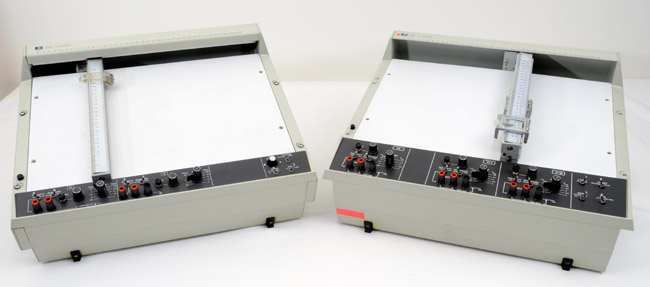 |
HP 7045A single pen, and 7046A dual pen X-Y recorder
HP Memory Collection |
A Continuously Evolving Product Line
The recorder product line would continue to stay in the general HP catalog up to the end of the 1980s. The HP 7045A, and HP 7046A, shown on the picture above, delivered the highest performance by the mid-1970s.
The 7045A is a A3 paper format, single pen X-Y recorder. It offers high speed and Y-axis acceleration exceeding 7620 cm/sec. 10 calibrated DC input ranges on each axis, from 0.25 mV/cm to 5 V/cm, in between, a 1-5-10 sequence is used. Most specifications are the same for the HP 7046A, but they applied to its two-pen writing mechanism (for multiple color displays), and three displayed parameters X-Y/Y.
|
Use your scrollwheel to zoom in/out
--
Click and drag to view other parts of the image when zoomed |
|
|
|
Bottom-Inside View of the 7046A X-Y Recorder
|
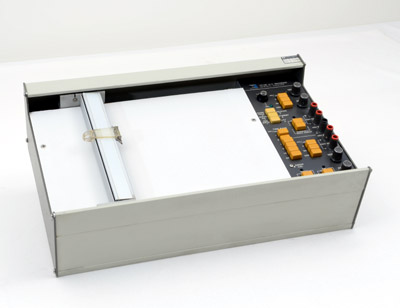 |
HP 7015B
|
The HP 7015B
The Model 7015B was the last recorder, newly introduced by HP in the 1978 catalog. It was a low cost A4 format, X-Y recorder with an internal timebase.
The 7015B offers full recording capability without add-on options or external equipment. It includes an internal time base, matched input filters, remote pen lift, and TTL level remote control.
The 7015B could be ordered with English or Metric option, with Input Ranges of 10 mV/in. to 1V/in. for the English version, or 0.5 mV/cm to 0.5 V/cm for the Metric option.
The internal Time Base can be slowed to 1/4 hour sweep and has automatic pen control and remote triggering for sweep start and reset.
The Time Base ranges are 0.5, 1.5, 10, 50, and 100 s/in. or 0.1, 0.5, 1.5, 10, and 50 s/cm for the Metric option.
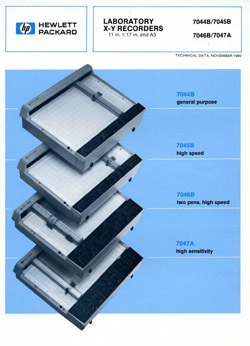 |
Technical Data of the HP 7044, 45, 46, and 47
Laboratory X-Y Recorders. November 1980
|
A Large Choice of Laboratory X-Y Recorders Was Still Produced by the Beginning 1980s
At a time when the digital plotter was beginning to make inroads to into the pure analog X-Y recorders, The HP general catalog still contained a lot of analog X-Y recorders.
The technical datasheet shown here, listed all the models of the 704XX series still available by the end of 1980.
Technical Data of the 7044B, 7045B, 7046B, and 7047A
Laboratory X-Y Recorders - November 1980 ( PDF, 1 Mb)
The Next Step: Interfacing with Computer
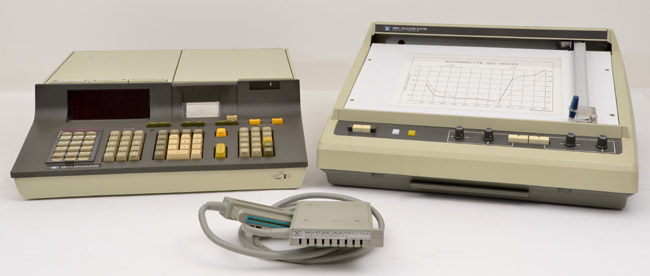 |
HP 9800 - Model 10 Computer, HP 9862A Digital Plotter, and dedicated Computer/Plotter Interface
HP Memory Collection |
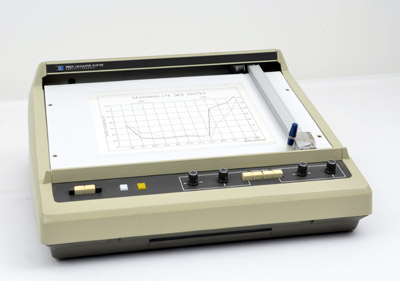 |
HP 9862A
|
The HP 9862A
The first Digital Plotter produced by HP was introduced in the 1973 catalog. Using a dedicated interface, it was compatible with the HP 9000, model 20, and 30, which were the second generation of HP desktop programmable calculators.
Designed a little before the introduction of the Hewlett Packard Interface Bus (HP-IB), this plotter didn't yet benefit from a sophisticated graphic language. ASCII characters were utilized in a brief and concise format to represent the position coordinates, and simple mnemonic commands controlled the plotting modes. Only a few program statements were needed to bring full graphics display to the plotter.
The Birth of the Hewlett Packard Graphics Language - HPGL
It soon became clear that a normalisation of the language used to address the plotter was crucial to customer convenience and programming efforts. At a time when processor speed, and memory cost were a major concern, this language had to use a syntax as short as possible. The earliest release of HPGL was limited to forty-three different instructions built in to equip the plotter with such capabilities as point digitizing, labeling, character sizing, scaling, and window plotting. These short easily understood instructions and the HP-IB interface enable the user to start plotting with only a minimum of programming experience.
This prehistoric release of the HPGL, would quickly become a standard, and continue to evolve through the 1980s, 1990s and 2000s. During these periods it was a must, for every new graphic software introduced on the computer market, to include an HPGL output directly driving an attached plotter or printer.
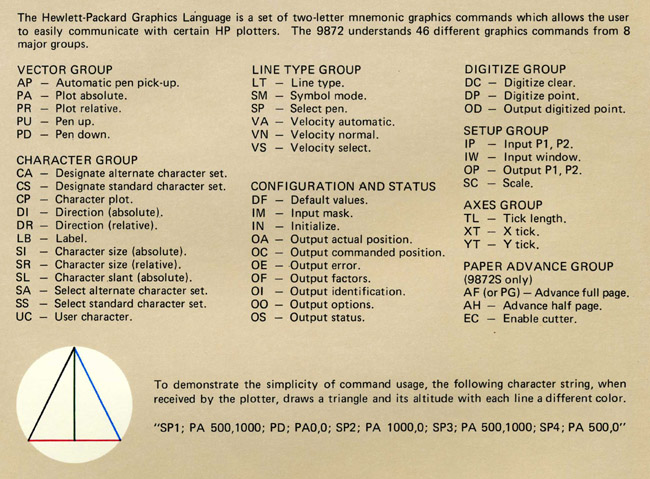 |
A short-form presentation of the Hewlett Packard Graphics Language , from a HP 9872B/9872S technical data sheet, June 1979
Courtesy of the Hewlett-Packard Company |
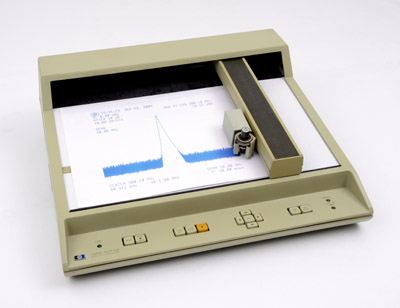 |
HP 7225A
|
The HP 7225A
The Model 7225A is a microprocessor-controlled plotter using linear step motor design.
Depending upon a selected Personality Module plug-in board, installed from the rear of the mainframe, the HP 7225A would provide the appropriate interface, language, and graphics capability for desktop computers, computer systems, and intelligent instrument systems.
Using the 17600A Personality Module, for example, provides the 7225A with compatibility for the HP 9815A, 9820A, 9821A, 9825A, and the 9830A/B computers.
The 17601A Personality Module adapts the 7225A to computer systems using the Hewlett Packard Interface Bus (HP-IB), with HP-GL intruction set.
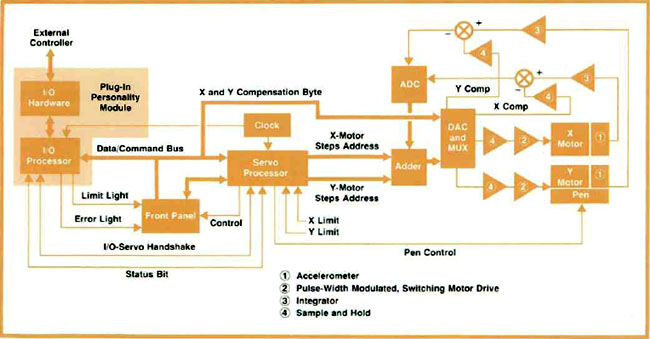 |
Model 7225A block diagram. Two microprocessors, one in the mainframe and one in the personality module, control all functions.
Each motor module contains a specially designed accelerometer that provides motor-movement feedback.
From the Hewlett Packard Journal, February 1979. Courtesy of the Hewlett-Packard Company |
 |
HP 9872B
HP Memory Project Collection
|
The HP 9872B, Multi-Color
The Hewlett-Packard 9872B is a microprocessor-based HP-IB plotter that produces high quality multicolor graphic plots on any paper size up to 285 x 432 mm (11 x 17) or ISO A3. The 9872B is interfaced through the Hewlett-Packard Interface Bus. With HP-IB system, the plotter can be connected to compatible calculator, computer, or other controllers using a standard interface cable.
Fast, high resolution plotting with excellent line quality is characteristic of the 9872. The pen is programmable to any one of 36 speeds from 10 mm/s to 360 mm/s. This feature produces high quality graphics on standard paper as well as other media such as clear film transparencies. Character plotting speed of over two characters per second can produce fully annotated graphics in minutes. Trace identification is enhanced by the use of the 9872's automatic selection of any of four pens through either program control or front panel pushbuttons. Replacing pens in their stalls effectively caps the pens preventing ink dry-out.
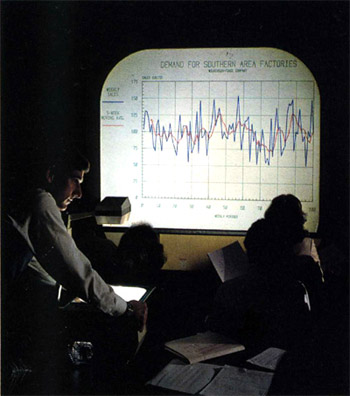 |
Project your data . . .
|
Opening a New Market
Graphics Communication
By the end of the 1970s the quality of graphics drawn by HP Plotters was such, that many services other than those having scientific activities, began to look at using this new tool for other business purposes.
The ability to create a visual representation of business or engineering data for overhead presentations at meetings or seminars first found immediate success within HP, leading quickly to offering this capability to customers.
An optional transparency kit enabled either plotter to produce low cost, high quality overhead transparencies for commercial applications. This was HP's first step into the consumable market. With HP's success in adapting to consumer markets, this led to the evolution of this marketing ability to the later LaserJet and InkJet Printers in the 1980s.
By the end of the 20th century, the consumable product line represented more than 5% of HP's turnover.
One of the very first HP Ads targeting the communication business is shown below. It comes from a HP 9872B/9872S technical data sheet published in June 1979.
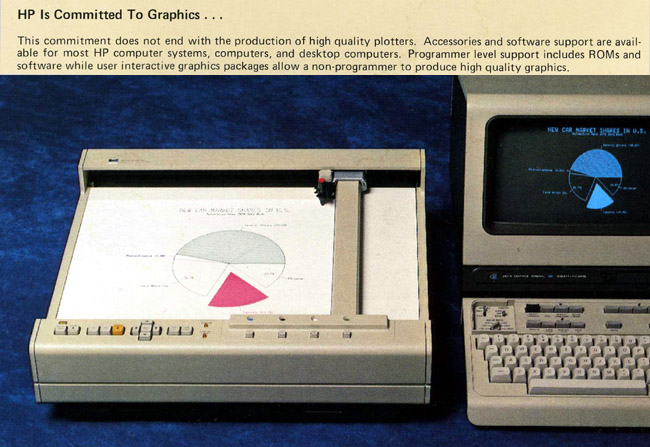 |
From a HP 9872B/9872S technical data sheet, June 1979
Courtesy of the Hewlett-Packard Company |
Pioneering Computer Graphics
For many reasons computer graphics was an early concern at HP. The most obvious was the intensive usage of graphing tools made by every engineering service inside HP since the origin of the company. Without question, it was this long term engineering practice with analog data recording that generated an immediate interest when computers opened a new age.
The considerable success of the HP's pocket calculator product line, by the beginning 1970s, also reinforced its ability to field a consumer marketing effort. This involved setting up distribution services different from the personal field engineer used for scientific sales, such as college bookstore sales efforts for the HP-35. This new product launched HP into the "consumer" market, and gave the company a Scientific Calculation leadership, with no competition for a few years. Extending this brand to the computer market, and adding products that give a visual graphic result of scientific calculation was an obvious evolution that HP's R&D labs quickly exploit. Previous experience with high quality x-y recorders produced for more than 15 years, gave HP a considerable advantage for the design of digital plotters.
In 1975, by adding the flexibility of the HP-IB for the interconnection, and the nascent but powerful Hewlett Packard Graphics Language, HP engineers became the leader in the computer graphics business. And happily, that's what they did, and it succeeded to a larger scale than anyone expected.
The quality of HP's Plotter quickly overpass the quality necessary in the laboratory, and began to generate interest in many other business. The main limitation in the beginning of computer graphics was the availability of dedicated software to help users in building every kind of visual representation of business data. At HP, as early as 1975, HP DRAW, running on the HP 3000 computer was developed and was available as a self-service in various places inside the company. A few years later, various Business Graphics software applications were developed to run on lighter hardware like the HP-85, HP 9845, or HP 9836. In 1983, the introduction of the HP 150 gave access to Business Graphics at the "Personal Computer" level.
The next step to boost the computer graphics business will be a revolution rather than an evolution. LaserJet and InkJet, nascent technologies in the beginning 1980s, will give HP another leadership, still driving HP leadership today.























